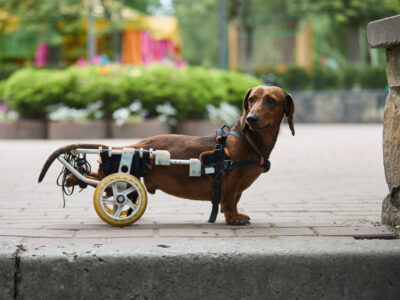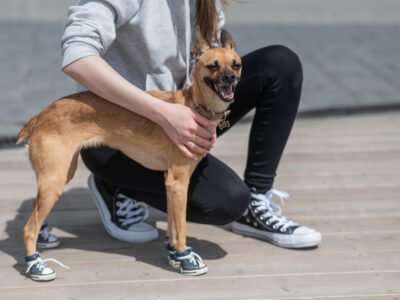
Spinal walking in dogs with paralysis is a crazy phenomenon that sounds more like the plot of a science-fiction movie than real science. If you’re not familiar with the term, spinal walking is the ability for a dog to walk when there is a permanent spinal cord injury. These pets use their reflexes to move, even though, their legs have stopped communicating with their brain.
In the past, only a small number of paraplegic dogs have developed the skill, so the concept wasn’t routinely discussed with pet owners. Today things are changing. We know the type spinal cord injury that responds best to learning how to spinal walk and methods to improve a dog’s chances.
The answers came from a group of veterinary researchers. Their goal was to uncover the common characteristics that made some dogs more likely to spinal walk than others. They found their evidence in the medical records of 81 paralyzed dogs.
Note: Please talk with your dog’s vet before starting any new procedure.
This post contains affiliate links. Read our policy.
What we know about spinal walking
The first thing we understand about spinal walking is the potential to master the skill is hardwired into the spinal cord. In fact, walking and movement in general are hardwired, instinctive behaviors.
Dogs who learn to spinal walk make their bodies move by using reflexes, muscle memory and help from the brainstem, even when they have no feeling or (Deep Pain Sensations) in their limbs.
“Spinal walking is a type of involuntary motor function that continues to work deep in the spine.”
VeterinaryPartner.com
The best candidates are dogs that have an injury to their lower spine that’s due to a herniated disc or a traumatic accident like being hit by a car.
Another quality these dogs have in common, is their participation in at least one form of rehabilitation. This includes: physical therapy, water therapy and massage. Apparently extensive rehab treatments help their bodies remap a pathway to movement.
One final point you should know about spinal walking is the way it looks. Dogs swing their legs underneath their body to move. They walk with a jerk in each step rather than taking smooth steps. Spinal walkers are also better at moving in a straight line. They don’t take turns well and have trouble changing direction.
Researchers think this happens because their brain isn’t coordinating the message to walk. Instead dogs propel themselves with their front legs while the back legs move in support.
The University of Bologna Study

Dr. Antonella Gallucci from the University of Bologna in Italy headed a study in 2017 that led to a better understanding of spinal walking. Her group of researchers analyzed the medical records from a previous clinical trial of 81 dogs with irreversible lower spinal cord lesions.
All of the participants had hind end paralysis and no deep pain sensations. Several breeds were represented, but more than half were Dachshunds.
And a new common denominator found in the group, was that every dog had been enrolled in an “intensive physiotherapeutic” program.
After pouring over the data, the researchers determined that 48 of the dogs (59%) learned how to spinal walk. The average length of time was 75.5 days, although some of the dogs walked as early as 16 days while others took an entire year to become mobile.
They also learned that the younger dogs, 5 years old and younger, and the lighter weight dogs of about 17lbs had the best results.
Dr. Gallucci’s conclusion was: Dogs with irreversible thoracolumbar lesions undergoing intensive physical therapy can acquire spinal walking.
You can read more about this study on the National Institute of Health website: Acquisition of Involuntary Spinal Locomotion (Spinal Walking) in Dogs with Irreversible Thoracolumbar Spinal Cord Lesion
How Scooter learned to spinal walk

Several years ago, I was introduced to a puppy named Scooter who became paralyzed after a car hit him and severed his spine. His pet mom, Jennifer Garrison, saw his story on the local news and adopted him.
Jennifer made sure Scooter received ongoing care during his recovery. At one visit to the neurologist, Jennifer was told that Scooter had good reflexes and could kick his back legs. The veterinarian said the dog was the perfect candidate to learn how to spinal walk.
Jennifer said she read everything should could find about physical therapy for dogs. She built an at-home obstacle course for Scooter and worked with him everyday to keep his muscles strong.
The exercises paid off and slowly Scooter began to use his hind legs. Today he spinal walks wherever he wants to go. He’s even learned how to climb the steps up to his house.
Here’s a video of Scooter when he first learned to spinal walk
One more quick story
In 2014 veterinary researchers at Iowa State University took the concept of spinal walking and tried to improve upon it. They combined physical therapy with injections of Chondroitinase, a medication that dissolves scar tissue. Their goal was to see if the nerves in the spine could regenerate when scar tissue was eliminated. Sixty dogs were enrolled in the study.
While the benefits of Chondroitinase are are being examined in an advance study at Texas A&M, it was clear that all of the participants benefitted from physical therapy. Many of the dogs were shown successfully walking on underwater treadmills and regular treadmills.
The study was another example about the benefits of physical therapy.
Not every paralyzed dog will be able to spinal walk, but I think it’s fascinating to learn about the possibilities.
Click to read more on the subject: 9 Dog Physical Therapy Exercises To Do At-Home





Sharon,
I am always asking you questions and you have been very helpful in your responses. I have a quadriplegic little chihuahua. When we sit her up she does not have balance to just to stay that way and rolls on her left or right side. Do you know of anything to support her so she can sit and look around? Thanks for your help.
Hi Jan, No problem asking me questions, keep em coming! I haven’t tried this, but other pet parents have talked about using a bean bag chair to prop up their dogs. They make them for infants so I’m sure you can find one small enough for your chihuahua. You can also use a rolled up bath towel. Or take a look at a child size inflatable round swim tube ring. Hope this helps. – Sharon
Thanks again Sharon for your article about spinal walking.
Gretchen is still paralyzed in the back after 12 laser therapies, 10 massages by a licensed therapist, at least 40 water therapies and about 15 accu puncture therapies by a licensed rehab doctor.
We tried a holistic doctor in Jacksonville who charged us $150 for a 10 min visit only to tell us that there is nothing he could do for her.
We keep our hopes up that she will develop a spinal walk, she is a smart dog and is in good spirits.
Hans
You’ve put a lot of effort into keeping Gretchen’s body strong. That’s got to count for a lot of her good health and good spirits. Unfortunately not every dog gets to the point where they can spinal walk. That includes my dog. You should be proud of all you’ve done to help Gretchen. I hope her health and happy life continue for a long time. Please give her a hug from me. -Sharon
We’ll done article on spinal walking Sharon! In late July our 15 year old dachshund, Cleo, suddenly lost use of her hind legs. We think she fell off one step outside. Due to her age we decided not to go with surgery.
She was started on steroid therapy along with Tramadol. We immediately bought a wheelchair from handicappedpets.com. Cleo seemed to be very depressed and confused about what had happened to her. We started her off using a sling to walk her to potty. I made it from a reusable canvas shopping bag.
Here it is the first of October and she uses her cart like a champ! Just in the last week she has started taking steps on her own!! We are thrilled beyond words.
I know the article says that the subjects of the study had no deep pain sensation. Cleo has had pain responses from the start.
I guess my question to you is that Cleo looks like Scooter when she’s walking. Can this be SW or do you think she might be regaining her ability to walk, ie; her brain communicating with her spine?
I plan on sharing this with our vet tomorrow when we go back for a recheck. She is still on a low dose steroid and continues to be on Tramadol.
I want to add that years ago we had adopted a paralyzed doxie, the rescue foster parents never had done any rehab and Hershey could only drag herself. Within a few months, we had her running!! It looked more like a fast bunny hop, but she was moving and so much happier.
We all as a whole, love our furbabies and they are part of the family!
Kim, I’m not a vet, but it seems like a good sign that Cleo is taking steps and has pain sensations. The fall might have bruised her spine rather than cause permanent paralysis. Talk with your vet about starting Cleo in water therapy or physical therapy. Rehab professionals are doing wonders. You might also want to discuss starting PT at home. Here’s an article with exercises you can do with your dog. https://dogwheelchairlife.com/9-dog-physical-therapy-exercises-you-can-do-at-home/
Thank you Sharon! We tried water therapy at home, oh my!! She didn’t like that, she thrashed around so much I had to take her out in fear for her hurting herself.
Our vet visit went well. Our vet was being cautious when telling us Cleo’s goal was to get better by 50%, she has surpassed that! We do exercises at home as well as massage.
Our problem is the area we live, we would have to drive one way 1 1/2 hours to find a rehab specialist. So we do what we can here at home.
I might add that since I posted Cleo can get up and take about 6 steps on her own! She’s very food oriented so we try to keep low-fat snacks for her. Mostly fruit and veggies.
Keep doing what you are doing. I think you’re okay as long Cleo is making progress.
Hi Sharon! I always find that your emails are full of useful information, you always have our furbabies wellbeing first and foremost.
In July, our 15 year old doxie that became paralyzed in her back legs. On the second day, I bought the wheelchair from Walking Wheels.
We immediately started using a sling to help keep her mobile.
It took her time to finally learn how to use her wheels. We exercised her several times a day, using the sling.
Our vet didn’t have much hope, she was wanting to try and get Cleo back 50% better.
Cleo started spinal walking in 3 months, we were thrilled and she seemed so happy with herself!!
I wanted to attach a video for you to share with others, but can’t. There is hope!! I just want to let others know to never give up, even when. your veterinarian has doubts.
Thank you for all you do.
Sincerely,
Kim
Kim, Thank you so much for sharing your story. I think a lot of dogs do better than their veterinarian thinks thanks to all of the new therapies. I’d be happy to share your video on our YouTube channel and on social media sites. You can mail it to: [email protected] Regards, Sharon
We had our first paralyzed dog 35 years ago, a 10 year old Doberman with no deep pain response and no reflexes at first. There was no therapy for dogs at that time, so her only therapy was walking in the first wheelchair Eddie made (which later inspired Eddie’s Wheels) . There were no stirrups so she dragged her paws on the ground, protected by baby slippers repaired with ductape. After 3 months of daily walks in the woods and on pavement, she started to pick up her feet and walk in the wheelchair. This was the beginning of spinal walking, a phenomenon our vet knew about in 1990. Three months later, she gave up her wheelchair and continued as a spinal walker, dying 3 years later at the age of 13.
Since we started making carts 25 years, we’ve seen so many dogs develop the ability to become spinal walkers just from walking in a cart with their feet in contact with the ground, and with homecare pt.
Leslie, thank you for sharing your story. I’m glad your dog was able to regain her ability to walk. It’s amazing how dog wheelchairs help so many dogs recover from mobility issues. Keep up the good work, you never know who will be helped next. – Sharon